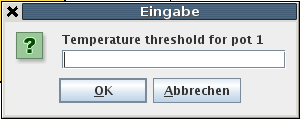Intelligent Systems Lab Project: Der Intelligente Kochtopf
Participants
- Robert Abel
- Benjamin Siemoneit
- Christian G. Wienhues
Supervisors
- Dipl.-Ing. Thomas Wöstenkühler
- Dr. Thomas Hermann
Motivation
- Users often face the problem to prevent the meal from boiling over.
- They need to constantly monitor the cooking process in order to do so.
- Some aspects of cooking could be automated by measuring temperatures and automatically controlling the stove using certain rules.
- This would take the burden off the users, to constantly check if everything is ok.
- Simple tasks, such as changing heat levels could be done automatically
Application Szenario
While heating milk (e.g. in order to cook rice pudding), the user leaves the kitchen to mow the grass. When he returns to the kitchen, he sees that the cooker has been automatically deactivated before the milk boiled over. He checks the temperature of the milk on the computer screen next to the pot and continues cooking.Objectives
The project goals are- Measure and display the temperature of a liquid inside a pot
- Display the state of the cooker
- Turn off the cooker when a temperature threshold is reached
Description
System overview
The following image shows our system's architecture.
- The program has been written in Java
- The client/server communication is realized via RMI
- The temperature data is contained in XML files
Hardware
Cognitronics and Sensor Systems Group's EES Board v3 [1]- ARM7TDMI Microcontroller LPC2136/01 by NXP/Philips
- USB serial port
- 8-channel 10-bit A/D converter
- Analog: PT1000 [2]
- -50°C to +205°C
- Digital: DS18B20 [3]
- -55°C to +125°C
The graphical user interface
The primary purpose of the graphical user interface is to clearly display the measured temperatures of cooking pots as well as the stove's status on a NEC LCD6520P display. Furthermore it shows cooking instructions and provides control over some stove functions. In the following, the various elements are described in detail (see upper screenshot).
 (1) Displays status messages coming in from the stove. Possible values: off, ready, active, error, service
(2) Shows cooking instructions for a particular pot (a stirring suggestion is implemented so far) as well as other messages (e.g. about the hob being deactivated when the temperature threshold is reached).
(3) In the four pot areas the measured temperatures (upper and lower sensor) of all pots placed on one of the cooking fields are displayed. The automatic mapping of measured values to the correct fields isn't fully implemented yet.
On click on one of the pot areas, a dialog shows up (see lower screenshot), where a temperature threshold can be specified (It is displayed under the lower temperature value). The hob will be deactivated automatically, when this threshold is reached.
(4) Schematic representation of the cooking surface. The circles represent the cooking fields, the numbers indicate the current heat level for each field. Moreover, the heat levels are colour-coded. Cold fields (level 0) are depicted in green. As the temperature increases, the colour gradually changes to first yellow, then to red (dark red for the highest level).
The amount of residual heat on fields, which are no longer active is shown in four steps (!, !!!, !!!, H, colour-coding as explained above).
(5) Buttons to
(1) Displays status messages coming in from the stove. Possible values: off, ready, active, error, service
(2) Shows cooking instructions for a particular pot (a stirring suggestion is implemented so far) as well as other messages (e.g. about the hob being deactivated when the temperature threshold is reached).
(3) In the four pot areas the measured temperatures (upper and lower sensor) of all pots placed on one of the cooking fields are displayed. The automatic mapping of measured values to the correct fields isn't fully implemented yet.
On click on one of the pot areas, a dialog shows up (see lower screenshot), where a temperature threshold can be specified (It is displayed under the lower temperature value). The hob will be deactivated automatically, when this threshold is reached.
(4) Schematic representation of the cooking surface. The circles represent the cooking fields, the numbers indicate the current heat level for each field. Moreover, the heat levels are colour-coded. Cold fields (level 0) are depicted in green. As the temperature increases, the colour gradually changes to first yellow, then to red (dark red for the highest level).
The amount of residual heat on fields, which are no longer active is shown in four steps (!, !!!, !!!, H, colour-coding as explained above).
(5) Buttons to
- deactivate the stove
- deactivate the hood
- toggle the hood's lighting
Results
- A pot has been equipped with two temperature sensors.
- The temperatures of the pot and the cooker's status are displayed in the GUI.
- The cooker automatically turns off when reaching a temperature threshold set by the user.
- The cooker, the hood and the hood's lighting can be manually deactivated using the GUI.
Discussion and Conclusion
- Most of our goals have been accomplished.
- Due to the cooker's induction field interfering with our sensors, we had to place them at the outside of the pot. However, the measurement is still slightly affected.
- Our sensor placement didn't allow to generate sensible stirring instructions.
- We couldn't give instructions concerning the cooking process, because a synergy with the RII group could not be realized.
Outlook
- Regulation of the liquid's temperature by controlling the level of the hob
- Add more sensors to obtain more detailed temperature information
- Calculate the temperature distribution and find a way to display it clearly
- Show cooking instructions (e.g. a stirring suggestion)
- Use a bluetooth board for wireless connection
References
[1] René Griessl, Dokumentation: EES Board V3, http://wwwhni.uni-paderborn.de/fileadmin/hni_sct/lehre/ees/download/ees_1011/EES_Board.pdf (26.10.2011)[2] Datasheet PT1000, http://www.baumer.com/uploads/datapool/PI/Pt100_Pt1000_UK.pdf (26.10.2011)
[3] Datasheet DS18B20, http://datasheets.maxim-ic.com/en/ds/DS18B20.pdf (26.10.2011)



